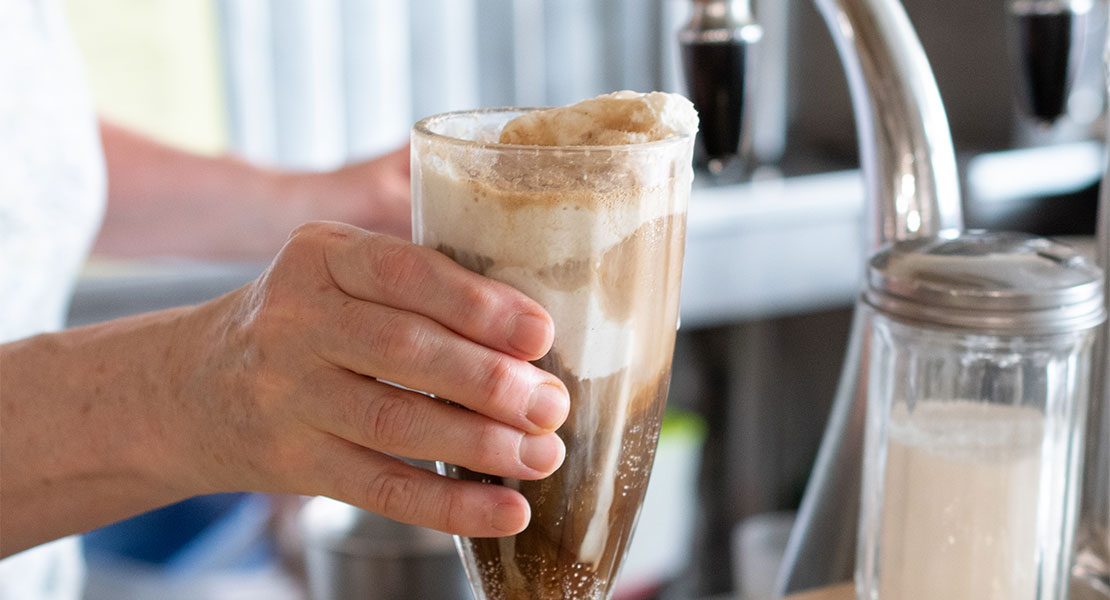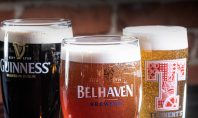Sine’s 5 & 10

Bill Harr Jr. met his wife, Gail, at Sines 5 & 10 in Quakertown. They were employees and often shared lunch at the counter, which still features a huge Hires root beer tap in working order, and where a long line of regulars’ coffee mugs hang from hooks. “A lot of marriages have come out of here,” says Bill’s sister, Linda Fox.
Bill Jr., who knows the exact spot for every customer’s cup, opens every morning, except Mondays, his day off. “If you want dad (Bill Harr Sr.), you need to be here in the morning,” he says.
Linda’s first memory of this enduring family institution that’s survived 107 years was looking under the 23 counter stools, including four short stacks for kids and “old ladies with short legs,” Bill Sr. says, to see the dried gum. Dad, who turns 86 this month, kneels down to check. “None,” he reports.
Linda began working in the store at age 15 for her grandparents: “To this day, I’d hate to let them down, to not keep this going,” she says.
Once, 5 & 10 stores were a dime a dozen. But F.W. Woolworth pulled out in the 1990s; Kresge morphed into Kmart, which now struggles. Some 5 & 10s are reinvented dollar stores. The Harrs endure with 11 strip malls, many with big-box retailers, within a five-mile radius. When the first opened, Plaza on 309, Bill’s father thought it was the end of Sines. “Now, we’re looking forward to outlasting Walmart,” Linda says from space that’s as suspended in time as the 230 model airplanes hung from the rafters, the year-round Christmas Room, and a massive collection of not-for-sale antiques that include Quakertown memorabilia.
It was 1912, and just months after Titanic sunk, Sines rose as Howard B. Sine’s Housefurnishing Store at 217 W. Broad St. Howard Sine, Harr’s maternal grandfather, moved to the current, now-expanded site in 1926. Five generations of family have worked here.
When Sine and his wife died, the business was passed on to their daughter and son-in-law, Theresa and Arthur Harr. Their son, Bill Sr., began working in the store at 14. He bought it with his wife Marlene in 1974. Their children, Bill Jr. and Linda, remain employees.
But there were once 31 employees after a Depression-era addition, and eight registers. Now, there are two, counting the register at the food counter.
What still sells best is candy. But even the candy in the penny candy bins doesn’t cost a penny anymore. It costs two cents. Once 32 varieties, now there are 10.
The family once bought toys directly from giant manufacturers like Hasboro, Milton Bradley, Tonka, Plasticville, and others. The last HO train set Bill Sr. looked into, a distributor required a minimum $10,000 order. “I’m not the boss anymore,” he says.
Since the late 1930s, Sines has belonged to 13 different buying groups, mostly distributors. Standard Syndicate Stores, which it joined in 1958, constituted a group of 54 kindred stores that held monthly meetings, paid dues, and helped each other buy merchandise from manufacturers by pooling orders, but it died slowly as stores closed. “As far as we know, we’re the only one left,” Linda says.
Today, most merchandise comes from Variety Distributors, Inc. Another like it, Cotter & Company, once had two divisions: True Value and Variety & Service (V&S), which had an Allentown warehouse. Then, one day, a Fed-Ex driver delivered the letter: The V&S half was disbanding to concentrate on the hardware (True Value) half. “One of the worst days in our long history,” she laments. “And where is True Value now?”
The times and challenges have made the Harrs more creative, thrifty, and smart. “The internet has helped,” Linda says.
Rather than longevity, Bill calls “stupidity” the key to survival. Linda calls it Pennsylvania German stubbornness. One common position: Sines isn’t a hobby business. “It’s a business,” Linda says, “and we want to stay in business.”
Sines almost closed in 2006. Literally S.O.S.—Save Our Store—signs went up in the display windows. That summer, through traffic on Broad Street was diverted for construction, but the family rode out the street closure and economic downturns, and replaced S.O.S. signs with a countdown to its 100th anniversary in 2012. Business spiked. “What it told us is that it matters to people that we’re here,” Linda says.
Proof is in the old store photographs on display, old posters advertising 10-cent milkshakes, a bill of sale from 1916—and the lunch counter, added in 1933, to include a soda fountain and ice cream. Today, breakfast and lunch (all homemade dishes) are still served. So does it really matter that a once more-industrial Quakertown had factory workers lined up three-deep for lunch?
In the end, Bill Sr. admits to his pride. “I’m not going to retire, I can tell you that,” he says. “Even if we do close, I’m still going to come in here, stand in the window, and wave at people.”


















